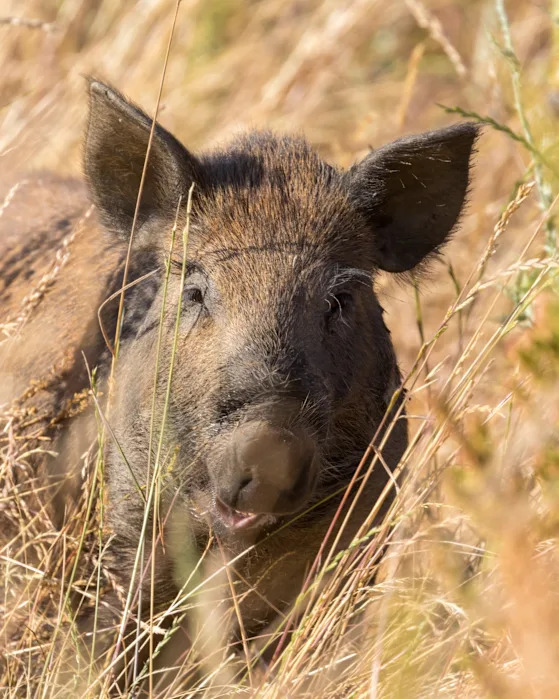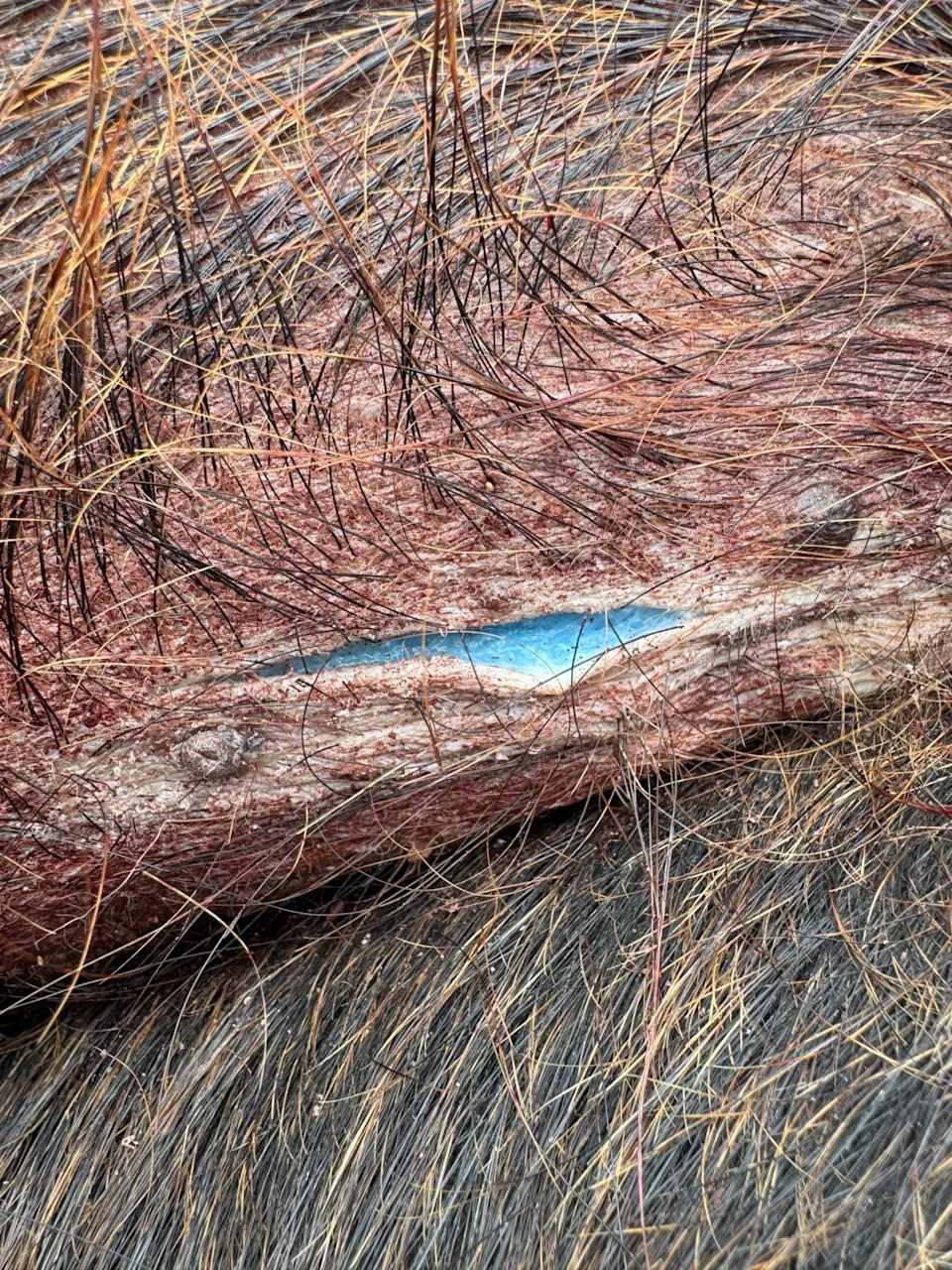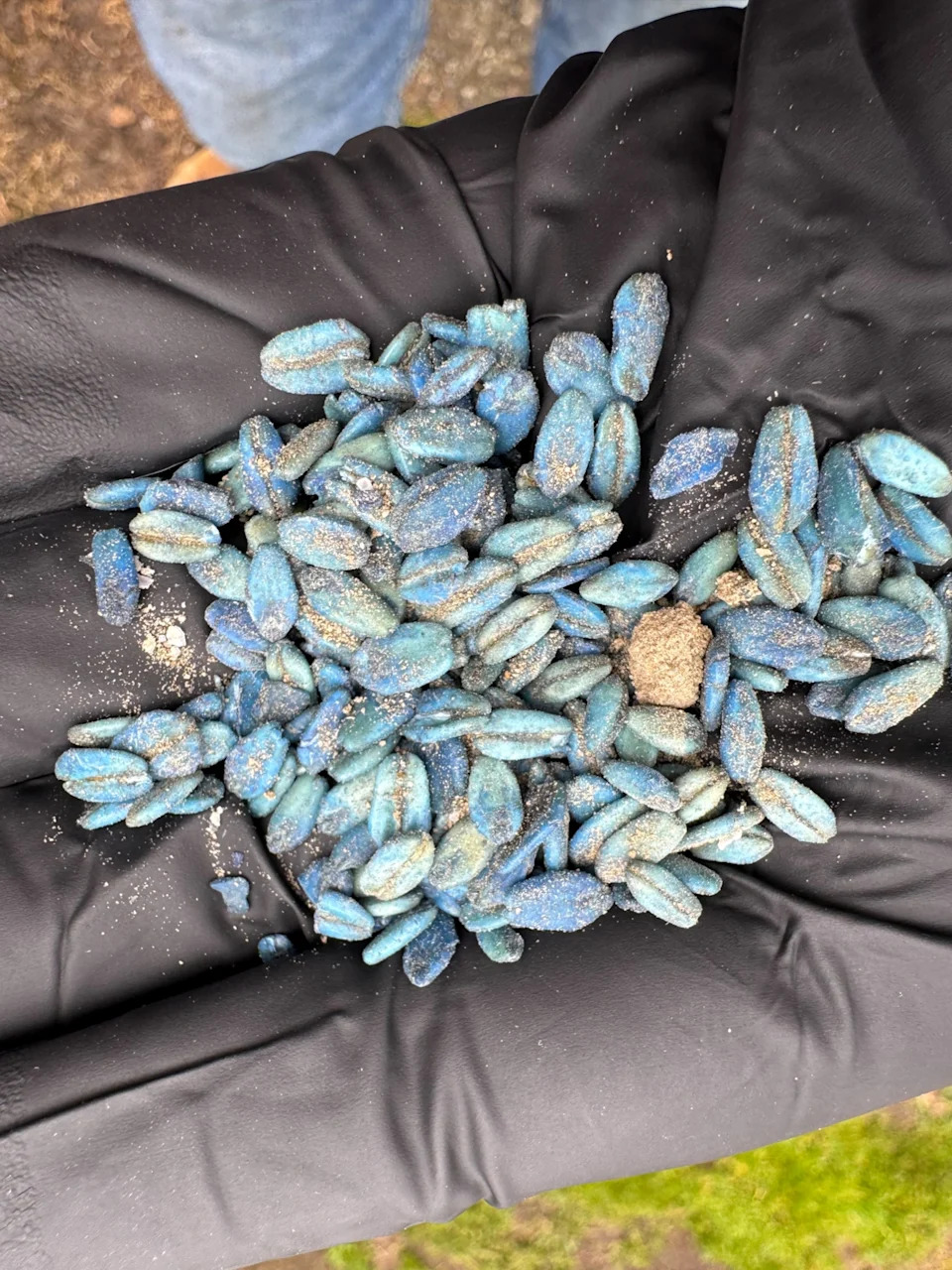
Dan Burton heard of pigs with electric blue meat in California years ago from an old-timer he used to hunt with, but he’d brushed it off as urban legend.
So when he cut open a dead wild pig in Monterey County, California, this past February, he was surprised to see blue fat— vivid, “7/11 slushie” blue—beneath the skin.
The color came from the blue dye of rodent poison, he correctly suspected, specifically from anticoagulant rodenticide bait containing the chemical diphacinone. He tipped off the California Department of Fish and Wildlife, which confirmed the presence of diphacinone and sounded the alarm to local hunters.
It wasn’t the first time.
Diphacinone is a restricted chemical in California, meant to be used only in specific circumstances for infestation control. The state tightly regulates anticoagulant rodenticides, but it doesn’t enforce a total ban. So it still shows up where it’s not supposed to be: in the bodies of many of California’s iconic animals, including condors, black bears, bobcats, and in the somewhat less beloved feral pigs.
(These widely used insecticides may be a threat to mammals, too)

Burton, who owns Urban Trapping Wildlife Control, was hired in late February to deal with wild pigs encroaching on an 800-acre ranch along the Salinas river. On multiple late-night stakeouts, he watched thick-furred pigs trot up from the banks of the Salinas to the ranch’s fence, snuffling for the ground squirrel bait stations affixed there—and the diphacinone-laced oats within.
The hard plastic bait containers were standard-issue and secure, but a California feral pig can weigh up to 200 pounds and makes “a worthy opponent,” said Burton. The pigs easily broke up the containers and scarfed up the blue pellets.
Months after Burton sent the California DFW a meat sample for lab testing in March, the agency posted a statement on July 30 warning local hunters to “use caution when harvesting game animals and be aware of potential risks.”
In large doses, diphacinone causes severe bleeding in humans and other mammals that can eventually be fatal. There isn’t a lot of science to detail how much game meat, and at what level of contamination, a person can eat before getting sick. One study from 2011 found that cooking it would not make it safe.
No other blue-tinged animals have been reported in Monterey County since March, said Krysten Kellum, Information Officer at the California Department of Fish and Wildlife, in an email. But the department has seen these reports before. A California feral pig made headlines a decade ago for its bizarre, cobalt-colored fat. And California hunters were warned of diphacinone contamination in 2021, after a flock of geese with blue innards were found in the San Francisco Bay area.
(The battle to control America’s most destructive species: feral pigs)
Diphacinone-laced rodent poisons won’t always turn animals brilliant blue, however, making it hard for hunters to identify contamination. The strength of color depends on how much dyed bait the animal eats.
Most diphacinone-polluted birds and bigger animals bypass the bait altogether, absorbing the chemical instead by preying on rodents that are themselves contaminated.
In 2018, anticoagulant rodenticides were found in the livers of 10 of 12 black bear samples collected from around California, 10 of 120 wild pigs, and zero of 37 mule deer, according to a 2018 study from the United States Department of Agriculture Wildlife Services. A data analysis by the Department of Pesticide Regulation found diphacinone contamination in more than half of 64 mountain lions tested from 2015 to 2016. Other studies have detected diphacinone in California condors, bobcats, black bears, San Joaquin kit foxes, red-tailed hawks and northern spotted owls.
“It’s really widespread poisoning,” said Jonathan Evans, Environmental Health Legal Director and senior attorney at the Center for Biological Diversity. “The ability of the anticoagulants to bioaccumulate through the food web is dramatic.”
In 2024, California capped a decade of growing restrictions on anticoagulant rodenticides with a bill that put them all on moratorium, except for agricultural use or in the protection of public health or water supplies. The bait stations that were bulldozed by the Monterey County pigs were legal, said Burton, the wildlife trapper. These restrictions are the most stringent of any state, said Evans—although they are not written in stone.
(Pest-control poison is a growing threat to Africa’s lions)

Nationally, the U.S. Environmental Protection Agency has also restricted who can buy and how much can be sold of the stronger, second-generation anticoagulant rodenticides. Still, across the U.S. there were over 3,000 reported ingestions of anticoagulant rodenticides in 2022, according to America’s Poison Centers’ 2022 annual report. Over half of those cases were of children under six years old.
The problem is, just replacing anticoagulants with other poisons would likely result in another, different set of ecological problems, said Lisa Owens Viani, director and co-founder of Raptors Are The Solution (RATS), an anti-rat poison organization.
“It’s great that we’ve been able to make progress on anticoagulants, but it’s not the end of the story by any means,” she said, pointing to good sanitation and anti-fertility treatments as alternatives.
New York City and Chicago have both attempted the fertility control route and the EPA has approved one product, ContraPest, which is non-toxic and induces early menopause in female rats when ingested. The same strategy could be employed against California ground squirrels, as surmised in a 2004 study.
Burton, the trapper, used to work in the pesticides industry, though he harbored a sour taste for it, disturbed by a childhood memory of his dog raiding a neighbor’s rat poison stash.
He doesn’t use pesticides now, though he sees how practical poison baits can be for farmers, who might not have the extra cash or time to devote to testing alternatives to readily available rodenticides.
But he’s a fourth-generation Monterey County native, and a semi-retired hunter. Just beyond the Soledad foothills, where he watched the blue pigs gorge themselves on diphacinone oats, he has also watched California condors soar above the jutting rock formations of Pinnacles National Park. In 2019, the state fully phased out lead ammunition after condors were found to be dying of lead poisoning from bullet fragments embedded in scavenged game.
“You know, the state banned lead ammunition all those years ago to protect the condor,” said Burton. “And then, you know, we have these pigs eating this poison.”








Comments